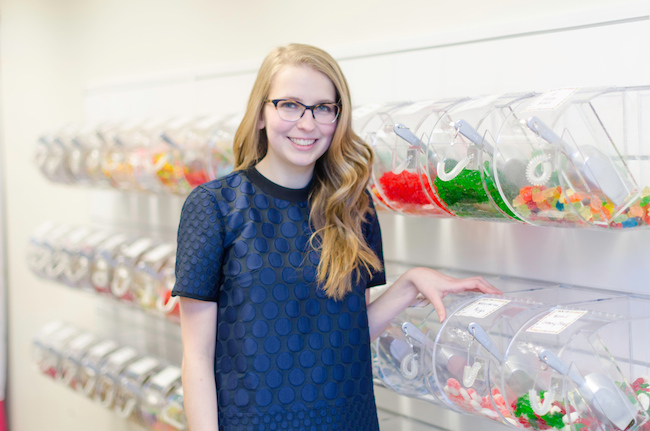When Jessica Landzberg arrived at the University of Washington in St. Louis Olin College of Business, she was a dean’s merit scholar. One morning, the dean brought her and three other merit scholars together for breakfast. They had all been picked, he said, in part because of their interest in entrepreneurship. He suggested that maybe they could get together and start an entrepreneurship club.
But Landzberg and her classmates — Mary-Brent Brown, Kailey Dreyfus, and Shea Gouldd — had another idea.
“We started the club, but we realized we wanted to have more than just that. We brought in speakers, and it was great to hear from successful entrepreneurs, but we wanted actual experience,” Landzberg says.
As it happens, Washington University had a way for them to get that experience, but they would have to work hard. STEP, the student entrepreneurship program, allows students to pitch storefront business ideas to the university, and if approved gives them space on campus to create a brick-and-mortar shop. The student-run businesses pay rent the university, but other than that, they produce their own startup-costs, and keep the profit. When the founding students graduate, they sell their shares in the business, and pass it down to lowerclassmen.
Landzberg and her classmates began looking into STEP, and realized there hadn’t been a new business in over eight years. Some of the older businesses, like UTrucking which helps students move, and Wash-U-Wash which does students’ laundry, had been around for as long as 30 years.
“So the four of us got together, and decided we wanted to start a business,” Landzberg says. “And we came up with the idea to open a candy store on campus.”
CREATING THE BEAR-Y SWEET SHOPPE
The idea was inspired by Landzberg’s past. As the youngest of four siblings, she was always dragged along to visit colleges, and later to visit her siblings at their chosen college – the University of Rochester. At the University of Rochester, Landzberg says her sisters would take her to a candy store, where someone behind the counter would fill a bag.
“It was always crowded in there, so that’s where the inspiration came from,” Landzberg says. “But we were able to take that concept and take it 100 steps further. With our candy store, you walk in and grab a bag, and we have 100 different options, 100 different bins of candy, and you fill it yourself and pay by weight.”
Once they had the idea for the Bear-y Sweet Shoppe, the four of them created a business plan and presented to the university. Once they were approved, Landzberg says they thought the hard part was over. But they were wrong.
“The hardest part was making it legitimate,” she says. “We had to file as an LLC, and we had to get many, many licenses, because we’re selling food. We had to make sure we were doing everything by the book – getting our licenses and filing taxes as a business.”
THEY ATE A LOT OF CANDY
But some of the planning was a lot of fun. To raise their initial funding, Landzberg says they launched a Kickstarter campaign, which raised $14,000, covering costs for the candy bins, cash register, and inventory.
And perhaps one of the most important parts of the planning was picking the candy. “A lot of people ask if we make the candy, and we do not. That would not turn out very well,” Landzberg says. “So part of what we had to decide was who our supplier was going to be, and that’s something we cared about a lot, because we wanted our candy to be high quality.”
Landzberg describes this part of the process as “trial and error.” Suppliers would send them samples, and they ate a lot of candy.
“We found the perfect supplier. This supplier consistently ranked number one for their gummies, and their chocolate was premium, and they had everything we wanted, so we wouldn’t have to worry about having multiple suppliers,” she says.
From there, they asked their friends what they would want to see in the candy store, and put together a first order. After the store opened, orders were sent out based on what was selling the fastest, and what customers requested.













Questions about this article? Email us or leave a comment below.